You Deserve Respect, Good Working Conditions, and Fair Wages.
We’ll Settle for Nothing Less


You Deserve Respect, Good Working Conditions, and Fair Wages.
We’ll Settle for Nothing Less

Advocating for patients. Advancing the profession.SM
Board of director S
President
Nancy hagans, r N, bSN, ccr N nancy.hagans@nysna.org
f irst Vice President
Judith cutchin, , DNP, r N, MSN judith.cutchin@nysna.org
Second Vice President
Marion enright, r N marion.enright@nysna.org
Secretary
Nella Pineda-Marcon, r N, bc nella.pineda-marcon@nysna.org
treasurer Jayne L. c ammisa, r N, bSN jayne.cammisa@nysna.org
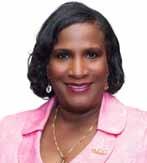
d irectors at Large
Matt a llen, r N, bSN matt.allen@nysna.org
Marie b oyle, r N, bSN marie.boyle@nysna.org
Seth b. Dressekie, r N, MSN, PM h NP, bc seth.dressekie@nysna.org
flandersia Jones, r N, bSN, MPh flandersia.jones@nysna.org
Michelle Jones, r N, MSN, a NP- c michelle.jones@nysna.org
Sonia M. Lawrence, r N, bSN sonia.lawrence@nysna.org
b enny K. Mathew, r N, MS, ccr N, ceN, Scr N benny.mathew@nysna.org
a ri Moma, r N, MS a ari.moma@nysna.org
Jean erica Padgett, r N jean.padgett@nysna.org
regional d irectors
Southeastern Vacant
Southern a retha Morgan, r N, MSN aretha.morgan@nysna.org
central catherine Dawson,rN,cNOr,MSN catherine.dawson@nysna.org
Lower hudson/NJ Margaret franks, r N
Western Steven bailey, r N steven.bailey@nysna.org
eastern b ill Schneider, r N, ccr N bill.schneider @nysna.org
editor Jennifer r farmer
e xecutive editor
Pat Kane, r N, cNO r
e xecutive Director
editorial offices located at: 131 W 33rd St., New york, N y 10001
Phone: 212-785-0157
email: nynurse@nysna.org
Website: www.nysna.org
Subscription rate: $33 per year
ISSN (Print) 1934-7588/ISSN (Online) 1934-7596
This month, many in the nation are celebrating Women’s History Month. This is a time to honor the luminaries who came before us, while celebrating those still living among and still inspiring us. It’s also a moment to take stock of how far we’ve come in New York, our governor and our attorney general are women, and for the first time in U.S. history, we have a Black woman serving on the United States Supreme Court. And how far we still must go women are still paid less than their male counterparts. We work hard, we do more with less, and we are still paid less than men even in industries, such as nursing, that are predominantly female.
In 2023, there are more women in the workforce, but that hasn’t led to pay equity in many industries. Additionally, while we have more women in leadership positions, women are still experiencing attacks on issues we hold dear such as reproductive freedom. For instance, the state of Texas just introduced a bill to ban abortion pills. It is a sad state of affairs that my mother had more rights than what my daughters presently enjoy.
But what I want you to know is that every day we have a choice of whether we will accept the status
quo or push back; whether we will accept other people’s vision for our lives or imagine and implement our own vision. I hope that we never adjust to the status quo, but rather continue fighting for and advancing positive change. I hope that we will acknowledge the challenges before us, without being scared into inaction. I also hope that we never lose sight of the many times we and those who came before us fought back and won.
Most recently, siblings at Mount Sinai Hospital and Montefiore Bronx went on strike for safe staffing and improved patient care. After three days on the picket line, nurses were able to reach groundbreaking agreements that increased staffing levels and enforcement, increased salaries by approximately 19%, protected healthcare benefits, and improved pandemic health and safety and community benefits. Our healthcare professionals could have accepted what their employers were offering. But they knew that accepting the boss’s offer meant accepting unsafe conditions for patients and nurses alike. They
knew that their willingness to stand for what was right would inspire and encourage other union siblings to do the same. Their courage was publicized with profiles and coverage in outlets such as ABC Nightline, Good Morning America, CNN, The New York Times, The Washington Post, and more. Attorney General James showed up at the picket line and countless others sent messages of solidarity.
As we reflect on the challenges facing our broader community, we must take the lessons of this strike and other victories with us. We must remember that when we fight, we win. And regardless of the challenge, nothing is impossible for people who refuse to quit.
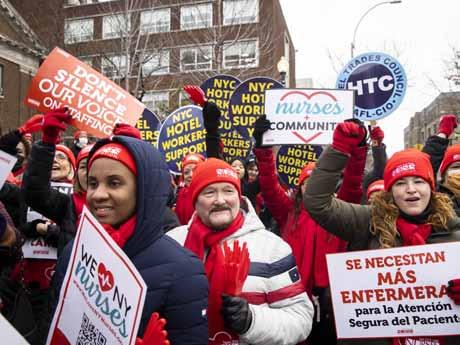
Additionally, as we move through Women’s History Month, I hope we have a deeper understanding of our calling. The work we do is not just for us, but for those who will come after us. The wins are never just for the people struggling in the moment, but for the people who will struggle if we refuse to stand up and fight. For instance, when we negotiate for fairer contracts, we know that we are providing a precedent and roadmap that will fuel future victories, even for people we may never meet. Women in and out of the labor movement must continue to organize, raise their voices and fight for themselves and future generations.
The question then is not just how we’re doing today, but rather how we’re ensuring the next generation is positioned to thrive. When we can affirmatively say that we are leaving future generations a better world, we can rest knowing that we’ve done our jobs. Until then, the fight continues.
It is a sad state of affairs that my mother had more rights than what my daughters presently enjoy.Montefiore nurses and community and labor allies walk the picket line.
understaffing at our public hospitals is driven by the enormous pay disparity between private- and public-sector nurses, which is only growing with the recent contract settlements for nurses in NYC’s private-sector hospitals. What was once an annual salary difference of $14,000/year will now be more than $19,000/year. This pay inequity will push even more H+H nurses out the door in search of much higher-paying jobs in the private sector. Such unequal pay will escalate understaffing and unequal care for New York’s predominantly working-class Black and Brown communities.
 By Pat Kane, RN NYSNA Executive Director
By Pat Kane, RN NYSNA Executive Director

New York City is facing the worst understaffing crisis we have ever seen in its public hospitals and Mayoral agencies, with nurses leaving for the private sector where they get higher pay and better working conditions. This must be addressed with a fair contract for the 9,000 NYSNA nurses who work for NYC H+H (our nation’s largest municipal health care delivery system of public hospitals, communitybased health centers, long-term care and rehabilitation facilities, correctional health services), and for our Mayoral agencies.
Let’s be clear, New York City’s public sector nurses are used to doing more with less. They saved our city while putting themselves at risk, preventing thousands of hospitalizations and deaths from COVID infections. It is time for the city to invest in our public health system by investing in frontline caregivers.
One of the ways the city can do this is by ensuring pay parity between the public and private sector. Parity isn’t charity. This is not just a nice thing to do, it is a health necessity. Patients need experienced nurses at the bedside, and that is compromised when hospital systems refuse to pay nurses what they need and deserve. Too many times, nurses of color and nurses serving communities of color, do not earn what they deserve. There is a devaluation of nurses of color and communities
of color and that shows up in what health systems are willing to pay.
There are also longstanding racial inequities that contribute to the lack of equal pay for nurses of color. The contract struggle involving H+H/Mayorals is a perfect moment to address both issues –pay equity between public and private sector nurses and health equity for our patients.
The lack of parity sets in motion a cascade of problems for both nurses and patients. When they cannot get what they need to care for their patients, community and family, nurses end up leaving. When nurses leave the public sector, communities or color lose trusted healthcare professionals who can meet their needs with compassion.
Nurses are the backbone of NYC’s public healthcare system. It is morally indefensible that we’re experiencing crisis-level understaffing. We have stressed to the public health system and policymakers that understaffing has only gotten worse since the start of the COVID19 pandemic. To be blunt, turnover is the worst we’ve ever seen. In some units the most senior nurse has only a year of experience. And other units are staffed by mostly expensive temporary travel nurses who don’t know our patients, our hospitals or our communities. We should be clear that parity is an issue of healthcare justice and racial justice. The crisis in
Most recently, the United States observed Equal Pay Day, which is the day that women’s salaries catch up with what men earned last year. As noted in the Equal Pay Day story in this publication, Equal Pay Day falls on different days depending on a person’s race. For instance, while Equal Pay Day for white women was March 8, Equal Pay Day for Asian American, Native Hawaiian and Pacific Islander Women is May 3. Black Women’s Equal Pay Day is Sept. 21. And Latina’s Equal Pay Day is Dec. 8. Latinas are paid 54 cents for every $1 paid to white men.
It is staggering that women of color are being left behind to such an alarming degree. But we must remember that the pain is doublyfelt for women of color and persons who work in the public sector. There is not only a disparity based on race, but a disparity based on public and private sector. NYC can and must do better.
NYC H+H/Mayorals cannot afford to continue shortchanging nurses. Hiring and training nurses who leave for the private sector is costly, but it also deprives the local community of healthcare professionals who know them and look like them. NYSNA will continue to fight for H+H/Mayorals nurses because they deserve it, but our patients and communities deserve it too.
To be blunt, turnover is the worst we’ve ever seen
anew NYSNA NYC Health+Hospitals/ Mayorals Executive Council was elected in March. It includes, (pictured here in this ad) Vice President Alizia McMyers, RN, President Sonia Lawrence, RN, Secretary Kristle Simms-Murphy, NP, RN.
Weeks prior, NYSNA nurses from New York City Health + Hospitals (H+H)/ Mayorals packed the courtyard outside H+H headquarters on Wednesday, Jan. 18, demanding a fair contract and safe staffing. Nurses held “I am a Nurse” signs honoring Dr. Martin Luther King Jr.’s legacy. The signs were a powerful reminder that public sector nurses are the backbone of New York City’s healthcare system and deserve respect.
On the heels of the contract victories in several private sector hospitals and with approximately 9,000 public sector NYSNA nurses with union contracts expiring in March, nurses spoke out demanding that New York City and H+H officials begin negotiations to prioritize safe
staffing, health equity, and pay equity in the public sector.
Nurses saved New York Nurses chanted, “We Saved New York,” reminding the public of their essential role during the pandemic. Despite being recognized as heroes in the wake of an unprecedented pandemic and being celebrated with the nightly banging of pots and pans, public hospital nurses have continued to endure unsafe staffing levels and a widening gap between their pay and the private sector, leading to high levels of turnover.
Joined by several City Council Members including, Chris Marte, Crystal Hudson, Shahana Hanif, Amanda Farias, and Selvena Brooks-Powers; and allies from community organizations like New York Communities for Change and The Poor People’s Campaign, nurses spoke out about the pressing issues they face while trying to keep New Yorkers healthy.
NYSNA First Vice President Dr. Judith Cutchin, DNP, RN, said: “Many of us have worked nonstop throughout the COVID-19 pandemic, working overtime, missing out on vacation, and putting our lives and the health of our families at risk to care for your families. We are exhausted and we are concerned. We are concerned about chronic understaffing that never seems to end.”
Nurses speak out
NYSNA Director at Large and H+H/Lincoln Hospital nurse Sonia Lawrence, RN, spoke out: “The gap between our pay and private-sector nurse pay is only getting bigger and more unfair. We congratulate our NYSNA siblings in the private sector for winning great contracts that will improve staffing, protect their healthcare benefits, and increase their pay. Now it’s our turn to do the same! Public sector nurses cannot wait months and months to settle a fair contract we will bleed too many nurses if the city waits to negotiate with us!”
NYSNA President Nancy Hagans, RN, BSN, CCRN, said:
“To my siblings in the public sector: All of the private sector is with you! All of NYSNA is with you! Nurses around the country are with you! Your fight for health equity is our fight and we won’t stop until we win a fair contract for the H+H and Mayorals nurses and health equity for ALL!”
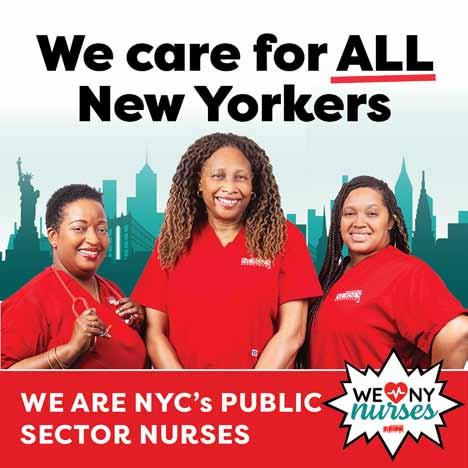
NYSNA Executive Director Pat Kane, RN, said: “This fight is not just the public sector nurses’ fight. This is a fight for the members of the communities they serve, day and night, 24/7, 365. This is a fight for all of us, and that’s why today we are calling on the management of H+H to support these nurses and bargain a fair contract!”
Council members expressed their commitment to supporting this contract fight and shared personal accounts of their connection to nurses, both as patients and family members.
“My late mother was a nurse at Harlem Hospital for over 30 years, and when she was diagnosed with Alzheimer’s disease, it felt like she didn’t have the care she needed despite providing New Yorkers with care her whole career. A fair contract will give our public sector nurses the care and compassion they deserve, while they show us that same care and compassion every single day,” said Council Member Crystal Hudson. And Council Member Shahana Hanif shared the deep care she received as a lupus patient and that her mother received by nurses who ensured her Bangla-speaking parents understood her condition and healthcare needs. After the speak-out, nurses marched on the boss, approaching the entrance of H+H headquarters by the hundreds calling for management to meet with them. While management did not come out and meet with nurses, nurses made sure their demands for safe staffing and a fair contract were heard loud and clear. The nurses know that being in a union and covered by a contract guarantees fair wages for all. They sealed the action with a promise as they chanted, “We’ll be back.”
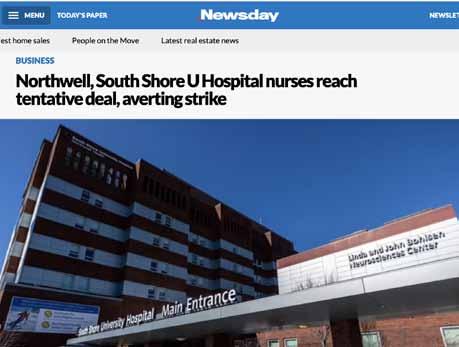
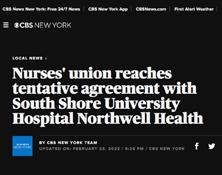
after approximately 99% of NYSNA nurses voted to authorize a strike at Northwell Health’s South Shore University Hospital, and months of negotiations, NYSNA healthcare professionals ratified a new contract.
Nearly 800 NYSNA nurses work at the hospital. As part of the new contract, NYSNA nurses won improvements to safe staffing standards, including expedited arbitration of staffing disputes to enforce new standards. They also won an average 18.65% salary increase over the life of the threeyear contract, including experience pay which will help with retaining nurses. The contract also includes the addition of Juneteenth as a paid holiday and improvement to retiree health benefits.
The nurses’ contract expired on Feb. 28, 2022, and nurses were in negotiations with the hospital for nearly a year. NYSNA members became frustrated with the progress of negotiations, understanding that patient care suffers when nurses experience poor working conditions and instability on the job.

This experience was one more reminder that when we fight, we win. Nurses shared their reactions below:
“Nurses fought for the care our patients deserve, and we won,” said NYSNA local president at South Shore University Hospital Chrysse Blau, RN. “The new safe staffing standards and salary increases mean more nurses will choose to come and stay at South Shore, it means more nurses at the bedside when our patients need us most, and most importantly, it means we get to practice safely and with the dignity and respect we deserve.”
“We are so relieved,” said Labor and delivery nurse at South Shore Arielle Shea, RN. “None of us wanted to strike, we simply wanted our voices to be heard. This contract is a testament to what nurses
can achieve when we fight together.
I’m so proud of my colleagues for standing up for our profession, for each other, and for our patients.
As a new mom myself, I’m excited to return to work knowing I will be able to provide excellent care to parents-to-be because of the improved staffing standards in our unit.”
“Whether you’re a nurse in New York City, Long Island, or Upstate,
you deserve respect and fair pay that will help hospitals recruit and retain a safe number of nurses at the bedside,” NYSNA President Nancy Hagans, RN, BSN, CCRN. “NYSNA nurses advocate for safe, quality care for every community, and all 42,000 members of NYSNA are in solidarity with our South Shore Northwell nurses. We are proud they fought and won a fair contract for nurses and patients.”
“Nurses fought for the care our patients deserve, and today we won.”a media and advertising campaign built support for Long Island rNs.
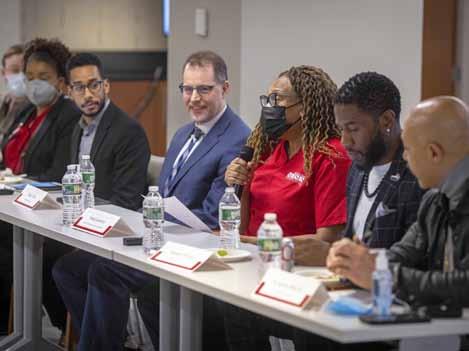
black History Month is an opportunity to recognize and honor the contributions of Black people while being inspired to follow in their footsteps or create one’s own unique path. NYSNA nurses from New York City Health + Hospitals (H+H)/ Mayorals held “I am a Nurse” signs honoring Dr. Martin Luther King Jr.’s legacy when they engaged in non-violent direct action on Jan. 18.
Although the U.S. has observed Black History Month for 53 years, in the past several years, we have
books being banned, affecting 1,648 unique book titles. Florida alone has banned between 501 and 750 books during that period.
Floridians are also witnessing a campaign to block Advanced Placement courses in African American Studies.
In the face of these attacks, we must follow the example of those who came before us and resist. The Black experience in the U.S. has been characterized by resistance and progress; resisting injustice, and charting a course for collective progress. In this moment, people of conscious must resist by engaging content and authors who challenge and inspire us to see beyond the current reality. We must also remember that Black history is American history it is all our heritage. And there are several examples of leaders who’ve come before us who envisioned and created lives and work worthy of emulation. Here are several important figures who have made Black history and contributed to the world as we know it today.
Estelle Massey Osborne paved the way for African American nurses to enter education and leadership roles in nursing. At the time she began nursing school in St. Louis, only 14 of 1,300 American nursing schools were open to Black students. She went on to Columbia University, where she became the first Black nurse in history to earn a master’s degree, and then was accepted to a position as assistant professor at New York University in 1946, becoming the school’s first Black faculty member. According to the American Nurses Association (ANA), she stepped into numerous leadership roles acting as president of the National Association of Colored Graduate Nurses, a member of the ANA board of directors and a delegate to the International Council of Nurses.
seen an onslaught of attacks on the very mention of Black history, let alone systemic racism. Some scholars theorize that the assault on Black history and discussions on race arose after coast to coast, multiracial protests over the killing of George Floyd. Since Floyd’s murder, we’ve seen widespread backlash on the teaching of race and history. But there have also been widespread book bans targeting Black authors; LGBTQIA+ authors; and those who seek to tell the truth about racism, sexism, homophobia and other societal harms. Renowned and prolific writers have had their work banned. For instance, from July 2021 to June 2022, PEN America listed 2,532 instances of individual
Adah Belle Thoms was named assistant superintendent of nurses at Lincoln Hospital in New York in 1906. While she spent the next 18 years acting as director, her race precluded her from being given the title, according to the National Museum of African American History & Culture Thoms cofounded the National Association of Colored Graduate Nurses and served as the organization’s president from 1916 to 1923, and she later successfully lobbied for Black nurses to serve in the American Red Cross Nursing and Army Nurse Corps during World War I. Thoms published the first chronicle of the history of Black nurses in America with her book “Pathfinders: A History of the Progress of Colored Graduate Nurses.” She was one the original inductees to the American Nurses Association Hall of Fame in 1976.
Bernadine Lacey chose her nursing school because it was the only one in the state that would accept Black students into the registered nursing (RN) program. According to the American Journal of Nursing, she and the other Black students were forced to sit in the back row, and a white instructor once told her, “You don’t have any business being this good” when she received high marks. That experience fueled her ambitions in nursing and led her to become an educator, political advocate and researcher. She became one of the first Black nurses in history to be admitted to Georgetown University, when she enrolled in its RN to Bachelor of Science in Nursing program, and she went on to become the founding director of the Western Michigan University Bronson School of Nursing. She received the American Academy of Nursing’s highest honor in 2014, when she was inducted as a “Living Legend.”
As you chart your own course, remember that you fly on the wings of monumental leaders like the individuals mentioned above. They are our history. And you are making our future.
for over one-quarter century, the nation has commemorated Equal Pay Day. The National Committee on Pay Equity started the recognition beginning in 1996. It is an opportunity to highlight the gender pay gap. But more importantly, it is the day that marks how far into the new year the average woman must work to match what her male counterparts made the year before.
In 2023, Equal Pay Day was observed on March 15. But not all women catch up on March 15. According to the American Association of University Women, which promotes equity and education for women and girls, Equal Pay Day falls on different days depending on a person’s identity and social location. For instance:
l Asian American, Native Hawaiian and Pacific Islander Women’s Equal Pay Day is May 3. Asian American and Pacific Islander women are paid 75 cents for every $1 paid to white men.
l LGBTQIA+ Equal
Pay Awareness Day is June 15. Without enough data to make calculations, this day raises awareness about the wage gap that LGBTQIA+ folks experience.
l Moms’ Equal Pay Day is Sept. 8. Moms are paid 58 cents for every $1 paid to dads.
l Black Women’s Equal Pay Day is Sept. 21. Black women are paid 58 cents for every $1 paid to white men.
l Native Women’s Equal Pay Day is Nov. 30. Native women are paid 51 cents for every $1 paid to white men.
l Latina’s Equal Pay Day is Dec. 8. Latinas are paid 54 cents for every $1 paid to white men.
“As a union of mostly women and people of color, NYSNA pauses to recognize Equal Pay Day,” said NYSNA President Nancy Hagans, RN, BSN. “We understand that women and people of color are particularly vulnerable to pay disparities. With each contract and each negotiation, we are mindful of the gender pay gap and understand the importance of fair contracts in helping women earn what they need and deserve.”
Particularly Resonant
Equal Pay Day also has resonance for nurses. Although the nursing profession is overwhelmingly comprised of women, men in the nursing profession typically enjoy higher salaries. According to Nurse Journal,
l Men report making an average of $7,300 more than women as registered nurses (RNs).
l The gender pay gap is even more significant and closing more slowly for women of color, who collectively comprise less than 17% of the RN workforce.
l Women RNs are paid 91 cents for every $1 men earn.
These disparities have persisted over decades. The Bureau of Labor Statistics reported “that women in 2020 earned only 82.3% of men’s annual earnings, compared to 57% in 1973.” And educational attainment doesn’t always narrow the gap. Having a union contract levels the playing field and reduces the gender pay gap. That’s why NYSNA will continue to fight for fair contracts that deliver good equitable pay.
NYSNA members traveled to Albany recently to participate in Caucus Weekend which was hosted by the Black, Puerto Rican, Hispanic & Asian Legislative Caucus. During the annual labor luncheon,

source
https://nursejournal.org/resources/ the-gender-pay-gap-in-nursing/

On March 23, the NYSNA nurses at One Brooklyn Health Interfaith Medical Center and Kingsbrook Jewish Medical Center unanimously ratified new contracts, bringing the historic campaign of 17,000 New York City private-sector members bargaining on a common platform to an end.
New York City private-sector nurses had been meeting and planning a major joint contract campaign for nearly one year. The campaign was the largest in NYSNA history, mobilizing a record number of members and resulting in groundbreaking gains in safe staffing, protecting benefits, wage increases, health and safety protections, and community benefits. Nurses at two hospitals, Montefiore Medical Center and Mount Sinai Hospital, engaged in a three-day strike in early January that captured the nation’s attention and delivered transformative victories for nurses, patients and the broader community.
NYSNA members at 12 hospitals with contracts expiring on Dec. 31, 2022, were facing cuts to their health benefits and employers at the
bargaining table who were more than happy with the status quo of small wage increases and lip service to safe staffing. Frustrated with the pace of negotiations, nurses at 10 of those hospitals voted on Dec. 22 to strike.

The strike vote started a timeline that brought focus to negotiations and pressured hospitals to respect nurses and their demands. Nurses spoke out in the media and gained tremendous public support and recognition for their heroism during the COVID-19 pandemic and the
challenging conditions they continue to face.
On New Year’s Eve, with contracts about to expire, NYSNA RNs delivered 10-day notices to strike at eight hospitals, setting into motion what could have been one of the largest nurses strikes in U.S. history. RNs spoke out about the shortstaffing crisis that puts patients at risk. They shared stories about their colleagues leaving the bedside and the professional all together because of current conditions. They drew attention to the dangerous working conditions and the need to continue good health benefits for themselves and their families.
New York City private-sector nurses were facing the real prospect of health benefit cuts at the hands of employer trustees of the NYSNA benefit plan that would reverberate beyond New York City to tens of thousands of NYSNA nurses in the state. Employer trustees were unwilling to increase rates to cover the rising cost of our health plan and instead tried to push cuts and costs onto NYSNA nurses. At the bargaining table, employers didn’t want to talk about wages until healthcare costs were settled. That all changed when Wyckoff Heights Medical Center agreed at bargain-
“With their historic victory, NYSNA members at Montefiore Bronx and Mount Sinai Hospital sparked a national movement to win wall-to-wall enforceable safe staffing ratios to make sure there are always enough nurses at the bedside of every patient at every hospital across the nation.”
NYSNA President Nancy Hagans, RN, BSN, CCRN
ing to pay whatever NYSNA Plan A would cost. Other hospitals followed suit, and the trustees agreed to increase the amount they pay into the plan to keep our quality healthcare coverage.
With escalating pressure and momentum from the healthcare
win, NewYork-Presbyterian was the first hospital to crumble, delivering a tentative agreement that improved staffing standards and enforcement; protected healthcare benefits; and increased salaries by 7%, 6% and 5%, respectively, during the three-year contract period. Several
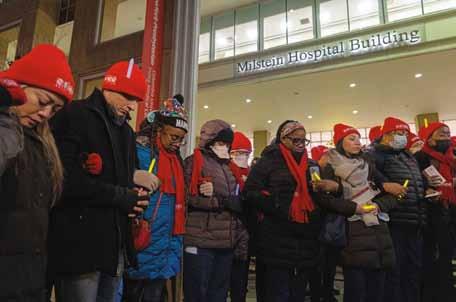

other hospitals soon followed that pattern: BronxCare Health System, Flushing Hospital Medical Center, Maimonides Medical Center, Mount Sinai Morningside and West, Richmond University Medical Center, The Brooklyn Hospital Center and Wyckoff Heights Medical Center.
Montefiore and Mount sinai Hold out
Executives at Montefiore and Mount Sinai instead dug in. Mount Sinai’s chief nursing officer insisted often and publicly that there would never be staffing ratios at the hospital. Montefiore bosses claimed it would be impossible to include Emergency Department ratios in the contract or invest in reopening units or preserving community health services. They tried to go on the media offensive, claiming that NYSNA nurses were being unreasonable by
cONTINueD frOM Page 9
not accepting the same wage “deal” that nurses at other New York City private hospitals accepted, failing to realize that union contracts are about more than dollars and cents.


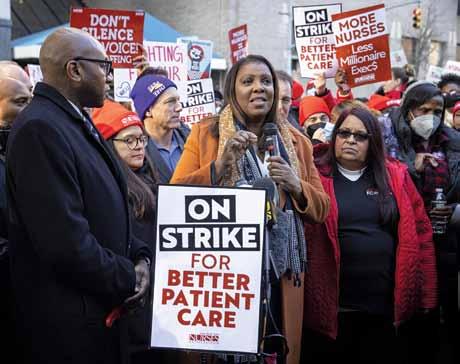
At 6 a.m. on Jan. 9, after several marathon negotiating sessions that failed to deliver tentative agreements, nurses at both facilities joined the strike line. Energy was electric, as nurses greeted their coworkers coming off the nightshift with homemade signs, cheers and hugs. There were three picket lines at the Montefiore Bronx facilities, where members kept spirits high with dancing and marching. Dozens of elected officials visited to support the nurses, and the media was a constant presence.
Members kept up the momentum outside for three days and nights from 7 a.m. to 7 p.m. as bargaining committees at both facilities were hard at work hammering out an agreement inside. When the breakthroughs came that ended the strike, nurses gained agreements that included enforceable nurse-topatient staffing ratios with expedited arbitration and potential financial penalties payable to nurses when employers fail to uphold contractual
safe staffing standards. Both facilities improved upon existing staffing standards in some areas exceeding California nurse-to-patient ratios. More details on the staffing victories at both facilities are available at www.nysna.org. Montefiore nurses won the community benefits and patient care improvements they had gone to the mat for.
This hard-fought campaign delivered major gains for tens of
thousands of nurses at wealthy academic medical centers and safety-net hospitals alike. Guided by unity and the moral calling to improve patient care, nurses held the line for what was right for their patients and the future of their profession.
Do you have reflections on this contract campaign and the strike that you’d like to share with NYSNA members? Let us know by emailing nynurse@nysna.org.

Nurses from New York City Health + Hospitals/ Mayorals kicked off their first bargaining session and presented a pay equity proposal. They were excited to be joined by City Council Hospitals Chair Mercedes Narcisse, RN, who fired up fellow nurses and offered words of support. This was their first meeting with the city officials to bargain, and they wasted no time, with more than 50 members attending to organize and build union power.
In early February, more than 50 nurse leaders from the NYC H+H/ Mayorals system attended a newly elected officer training. Executive committee members shared their vision for improving care at the nation’s oldest and largest public hospital system, learned about the H+H and NYSNA governance
structure, and brainstormed ways to build NYSNA’s strength in facilities by recruiting more leaders. Facilitated by NYSNA’s Labor Education department, the all-day training provided an opportunity for participants to practice skills
like preparing as a committee for a meeting with management and representing coworkers when supervisors question them. Visit NYSNA’s Labor Education web page or contact labored@nysna.org to receive information on similar trainings.
Before the ink had even dried on their new contract, nurses and retirees had to fight for NewYork-Presbyterian to deliver on their agreements. Retiree nurses gathered outside CEO Dr. Steven Corwin’s Manhattan apartment on Feb. 2 to demand NewYorkPresbyterian leadership refrain from doubling healthcare rates for retirees and violating the new contract. They previously organized a speak-out and sit-in, by sleeping overnight in the hospital lobby and
demanded hospital administrators honor the healthcare premium rates that were previously confirmed after their contract was ratified. With the enrollment deadline looming, retirees called on Corwin to respect retirees and stop increasing healthcare costs. Nurses demanded hospital administrators honor the healthcare premium rates that were confirmed before and after their new contract was ratified.
In sum, nurses and retirees at NewYork-Presbyterian have been
fighting against management’s attempts to double the cost of retiree health benefits in violation of their new contract.
On March 10, an arbitrator ruled in favor of nurses and retirees. The ruling secures retirees’ agreed-upon health benefits and stops management’s infringement. NYSNA applauds all the active and retired members who kept the pressure on by speaking out, holding demonstrations and delivering petitions to leadership to defend retirees’ health benefits.
Samaritan Medical Center nurses in Watertown have ratified a new three-year contract. The agreement provides a tremendous win for safe staffing with enforceable staffing ratios throughout the hospital. Additionally, nurses received unprecedented increases to base pay, shift differential, charge and preceptor pay. This was the first contract that Samaritan nurses negotiated since the beginning of the COVID-19 pandemic.
The contract win came on the heels of a successful informational picket on Thursday, Feb. 2, when hundreds of nurses rallied in front
of the hospital to demand safe staffing and a fair contract.
The cold and snow did not deter Samaritan nurses from marching and making their voices heard. Nurses marched and demanded enforceable safe staffing standards and a real plan to hire and retain enough nurses to support quality care.


During the event, nurses spoke out about the understaffing crisis throughout the hospital, especially on medical-surgical, critical care, and mental health units, and in the emergency department. Their info-picket garnered widespread press attention and built momentum as they headed back to the bargaining table.

adirondack Medical Center nurses have been calling on management to deliver a fair contract that includes safe staffing, a safe work environment, and the benefits and wages nurses
deserve. On Feb. 8, the bargaining unit delivered a petition signed by nurses. Now they’re looking to the community for support. You can show your solidarity by signing their petition for a fair and just
contract. Adirondack Health must invest in our community by negotiating a fair contract. This is our community, our hospital and our nurses. Sign the petition today: bit.ly/adinurses.
NYsNAPresident Nancy Hagans was appointed to the Council of Presidents for National Nurses United (NNU). In this capacity, she’ll add her voice to a collective of nurse advocates leading the largest nurses’ union and professional association in the United States. The New York

State Nurses Association (NYSNA) voted to affiliate with NNU in October 2022, and Hagans became an NNU president in December 2022.
The NNU compiled an excellent profile of Hagans, which I encourage you to read here: https://www. nationalnursesunited.org/article/born-leader.

In the spirit of continuing to define and strengthen our union and vision, the NYSNA Board of Directors approved a new Mission and Vision statement at its February meeting. It’s included here:
The New York State Nurses Association (NYSNA) is the largest nurses’ union and professional association for registered nurses in New York State, representing more than 42,000 members for collective bargaining, advocating for professional nursing standards of practice, and promoting the health and welfare of our members, our profession, and the people of New York. As a powerful union and organization made up of and led by nurses and healthcare professionals, we understand the vital role that we play in providing healthcare to all who need it, protecting the public health, and promoting the well-being of nurses in our workplaces, in our communities and in the political sphere. As a powerful and growing organization, NYSNA is defined by our commitment to:
1. Advocating for and protecting the interests of all nurses and our profession as a whole.
2. Leading the fight for healthcare equity, social, racial and economic justice, and the well-being of the people of the communities in which we live and work.
3. Promoting and achieving the highest possible level
of professional nursing practice, quality of patient care, and health outcomes for our patients.
4. Tenaciously fighting to improve wages, retirement security, health benefits, safe staffing, and safe working conditions through collective bargaining and aggressive enforcement of the rights of members in their workplaces.
5. Leading the fight to address environmental and social determinants of health to ensure the wellbeing of future generations.
6. Building up and empowering nurses to assume our leadership role as advocates in the profession, the healthcare system, the political process, and our local communities.
7. Fostering emotional well-being and workplace wellness to fully support our profession and patients.
8. Providing mentorship, support and collaboration needed to develop and continue the traditions of nursing practice, advance the nursing profession to meet the needs of our communities, and develop and nurture the next generation of nurse leaders and advocates.

advocates and spiritual leaders have long said that budgets are moral documents you can tell the values and priorities of a people by how they allocate resources. With this in mind, hundreds of NYSNA nurses descended on Albany on March 22 to lobby for greater investment in healthcare to support frontline healthcare professionals, our patients, and the goal of ending racial and social disparities in healthcare.
New York’s nurses and patients just went through a winter tridemic of COVID-19, flu, and RSV, which drove high rates of hospitalization and deaths. With March marking the three-year anniversary of the COVID-19 pandemic, New York is also facing a migrant crisis and a mental health crisis that impact healthcare delivery throughout the state. Our public and safety-net hospitals are shouldering a disproportionate share of the difficult and underfunded care for migrants and patients with complex mental health needs, while our nurses are understaffed and under resourced.
Given our current crisis, NYSNA members organized a speak-out outside State Senate chambers and met with legislators to emphasize that our healthcare system needs more support from the state budget in order to ensure fair funding for safety-net and public hospitals and enough nurses to provide qual-

ity care to all New Yorkers. The state budget must support health equity. More than thirty legislators stood alongside NYSNA nurses and echoed our call for budget justice, including State Senate Majority Leader Andrea StewartCousins, Sen. Robert Jackson, Sen. Jessica Ramos, and Assembly Members and registered nurses, Phara Souffrant Forrest and Karines Reyes. An advocate from Make the Road New York spoke out about extending healthcare coverage to all, including immigrant New Yorkers.
NYSNA nurses were pleased to see the State Senate and Assembly budget proposals improve upon Governor Hochul’s budget proposal to direct funding where it’s needed most and address our core issues, including: protecting nursing practice standards; fair funding for safety-net and public hospitals; regulating temporary nurse staffing
agencies; and expanding access to care.
In more than a dozen meetings with legislators throughout the day, NYSNA nurses lobbied for additional funding for safe staffing both to educate, recruit and train more nurses and to ensure hospitals and nursing homes follow the law and consistently meet safe staffing standards. Clearly, there’s more work to be done to ensure the enacted budget reflects our values and truly helps deliver the healthcare that New Yorkers deserve. That’s why NYSNA members will be closely watching the budget negotiations between the governor, state senate and state assembly as we approach the April budget deadline, and we will continue to push for fair healthcare funding and policies that meet the moment we are in.

Women’s History Month is an excellent opportunity to highlight the accomplishments and advocacy of women. It’s also as good a time as any to issue a reminder on the continuing crisis in maternal health, particularly for women of color. I offer this assessment as someone who has spent the past 22 years as a home care nurse.

I work for Montefiore Medical Center, which is in the Bronx. I am also NYSNA’s chair for the Montefiore home care division. By way of background, you must know that the Bronx has some of the worst health outcomes in the nation. We rank dead last in health of any county in New York State 62 out of 62. That is problematic for maternal health.
Broadly speaking, across the nation, women of color are 3 times more likely to die than white women due to maternal complications. The Bronx has the highest infant mortality rate in New York
City. And for years, Montefiore home care nurses have served this vulnerable population.
But within the last three years, Montefiore has phased out its maternal health home care program. When we were able to visit new mothers in their homes, we could catch preeclampsia, postpartum depression, and identify a myriad of postpartum complications and social issues. During these visits we could also offer wound care treatment and teach new moms how to breastfeed.
Although NYSNA succeeded in saving the Montefiore Nurse Family Partnership program, a critical lifeline for vulnerable mothers and babies, our work is far from over. NYSNA negotiated to have the program extended for another year, but the fight now is to get it extended indefinitely. We must continue to fight for preventative health programs, given that women of color continue to die at alarming rates from health conditions that could be avoided if caught early.
Without preventative care, new mothers are more likely to end up in the emergency room, have stokes or suffer other serious conditions that could have been avoided if they had preventative care.

We must continue to ensure that all hospitals put patients before profits. That means investing in home critical care services including infusion care, care for end-stage heart failure patients and maternal care. It also means hiring and retaining nurses.
Access to care in the most vulnerable communities is only one small but important part of reducing systematic racism in healthacre. Organized nurses and healthcare workers must also push for hospitals and regulators to meet racial equity benchmarks. To address maternal health and health equity, hospitals must see beyond dollars, and put patients first.
Although NYSNA saved the Montefiore Nurse-Family Partnership program, a critical lifeline for vulnerable mothers and babies, our work is far from over.

 By Rony Curvelo
By Rony Curvelo
The New York Relief Network (NYRN) completed its 55th mission in Chiang Mai, which is in the northern part of Thailand. Our team of 10 health professionals comprised eight registered nurses and two nurse practitioners. We provided health care to 261 patients.
NYRN participants traveled to the Kayan Tribe, as they did two previous times. Per the tribe’s request, the delegation visited the Karen Tribe, also part of the Kayan people but from a different location. The Kayans or Karens, or any other longneck tribe, have no right to health care unless they pay an unreasonable amount in cash. For example, if Thai citizens go to a
clinic for any primary consultation, they will never pay more than TBH 30,00, equivalent to 90 cents USD. If any of the tribe members want the same service, they must pay TBH 2,000, equal to 60.60 USD. The cost is simply unaffordable.
The NYRN team also donated bags of rice and vegetables, and the donation helped ensure there was sufficient food for all. NYRN is the only medical team that visits the region yearly.
Additionally, the NYRN also provided healthcare to the Phrao village in the rural area of Chiang Mai (a two-hour drive). According to the UN, 79% of the poor population of Thailand remain in rural areas and mainly in agricultural regions, like Phrao.
Please visit the NYRN Facebook and/or Instagram page to see photos or learn more: https://www. facebook.com/NYReliefNetwork And stay tuned for updates on future visits.
